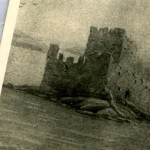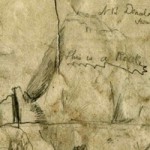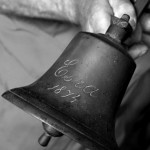Category: Artefacts
Stac Dhomhnaill Chaim in 1849
The Esra Bell
Crusies
no images were found
A stone mould for a crusie, an oil lamp of ancient design once in common use throughout the Hebrides.This mould, of unknown provenance, is in our museum collection but unfortunately we don’t have a crusie itself, much as we would love to. (This piece is the first in an occasional series on objects in our collection.) From Highland Folk Ways, Isabel F Grant (1961):
Crusies were mainly used in the islands and the coastwise districts because fish oil was the usual illuminant (although mutton fat might be used). The crusie consisted of two leaf-shaped vessels, the upper one fixed on a ratchet above the lower one, so that the drip should be caught and the crusie could be tilted forward to use every drop of the oil. I have been told that peeling the rushes which were used as wicks was one of the children’s jobs. A thin sliver of the outside was always left to prevent the pith from breaking. Occasionally square crusies were made with four lips and I have been told that these were used by craftsmen.
To make crusies a thin plate of iron was hammered into a mould and some Highland blacksmiths had such a mould in the corner of their anvils, but I had a crusie-mould made of stone that came from the island of Tiree. Crusies vary much in shape, some clumsy, others elegant, and also in the amount of iron used in their making. A few have decorative curley-worleys on the back of the crusie. I have, however, twice come across crusies made out of a natural knot of firewood, one of the many devices for economising the use of iron, and I have seen a prehistoric stone lamp that had evidently been used in later times. Middle-aged people [in 1961] can remember when crusies were still sometimes used to light byres or threshing barns.
One notable difference in the Hebrides was the use of bird oil in the lamps.
A study of the crusie, particularly in its Zetlandic form and Norse origins, was made by Gilbert Goudie for the Scottish Society of Antiquities and published by in the Proceedings of the Society of 23 January 1888:
The Crusie, like many articles indispensable at one time in domestic use, has passed quietly out of view, superseded by more modern appliances. Too common, too trivial for the notice of the historian, it has left in its demise scarcely so much as an epitaph. The name, and a vague impression of what it may have been, is perhaps all that is known of it to the younger grade of the present generation.
Turning to the Encyclopaedia Britannica, 9th edition, we find the following description of the primitive lamp of this country:-
The simple form which was used down to the end of the eighteenth century, and which as a ‘crusie’ continued in common use in Scotland till the middle of this century, illustrates the most elementary and most imperfect arrangement of a lamp. Here, as in the lamps of antiquity, the oil vessel lies immediately behind the burning point of the wick, with which the oil is about level when the reservoir is full. The wick is a round soft cord or fibrous mass. Such a lamp has no merit but simplicity. The light is thrown only forward and to the sides, the back being entirely in shadow. The wick, being a round solid mass, takes up the oil equally at the centre and circumference; but to the outer edges of the flame only is there any access of air; consequently combustion in the centre is imperfect, resulting in a smoky, unsteady flame, and a discharge into the atmosphere of the acrid products of destructive distillation. Further as the level of oil sinks in the reservoir, the wick has to feed the flame a greater distance by mere capillary force, and, the supply thus diminishing, the light decreases in proportion.
Such is the latest, and probably the fullest and most authentic description of the old Scottish lamp available for general readers; and though imperfect, and with some slight misunderstandings, it is fairly accurate. But no drawing is given, and the precise form and dimensions are open to conjecture.




